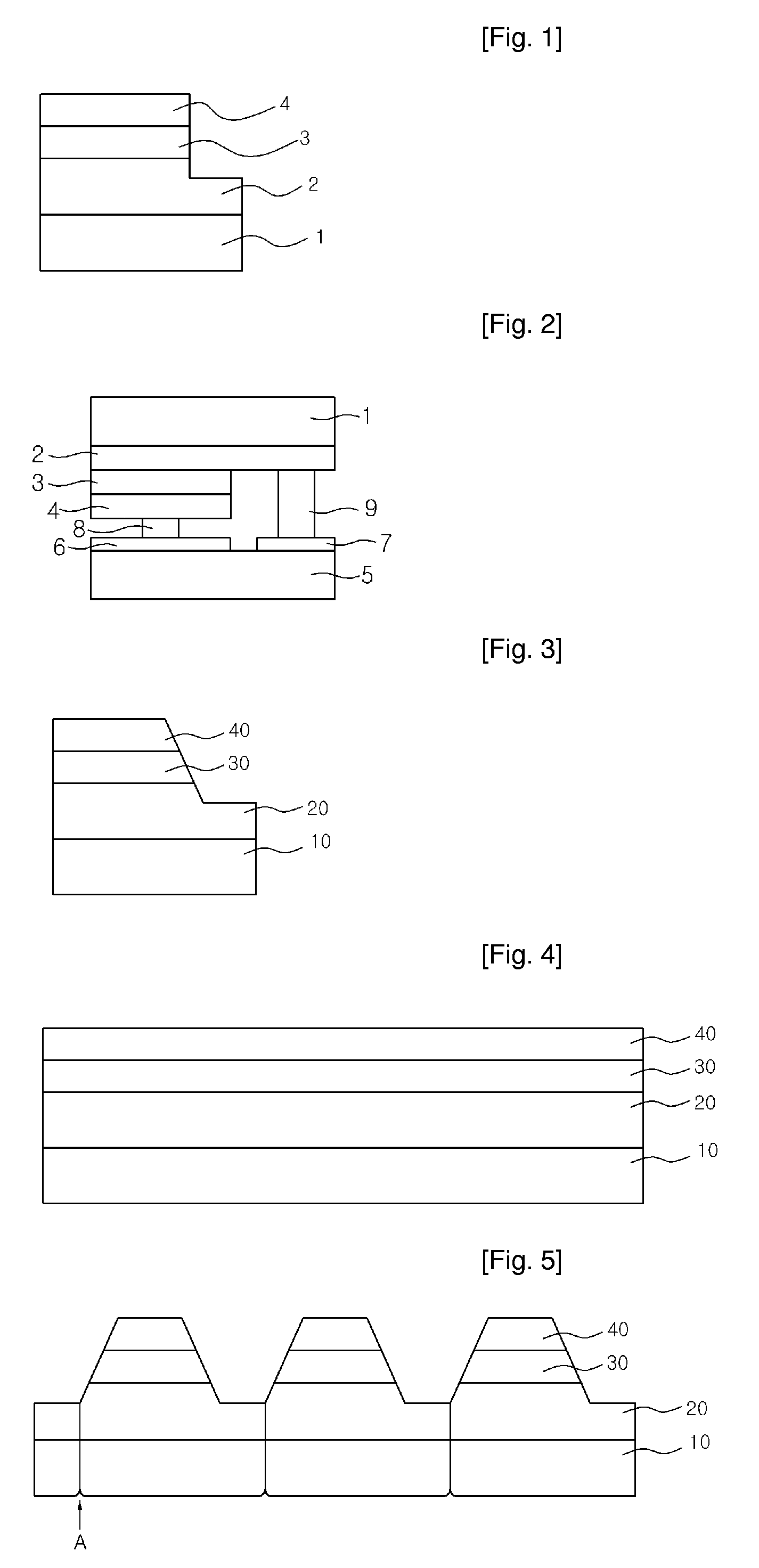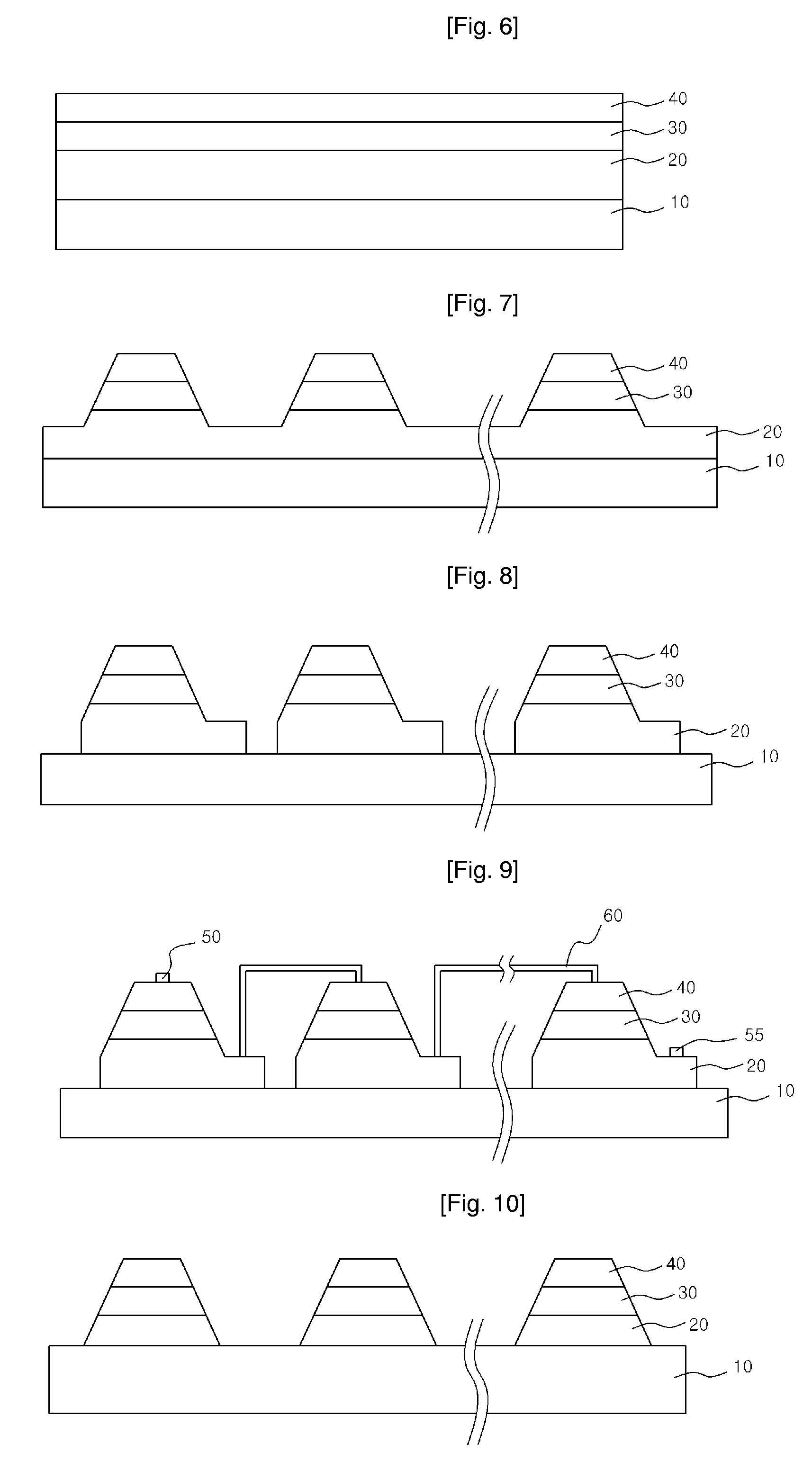Light Emitting Device and Method of Manufacturing the Same
a technology of light emitting devices and manufacturing methods, which is applied in the direction of semiconductor/solid-state device manufacturing, semiconductor devices, electrical devices, etc., can solve the problems of low luminous efficiency in which electric energy is converted into light energy, the light is then emitted to the outside of the light emitting device, and the amount of light to be totally reflected is not emitted to the outside but dissipated within, etc., to achieve enhanced light extraction efficiency, high luminous intensity and brightness
- Summary
- Abstract
- Description
- Claims
- Application Information
AI Technical Summary
Benefits of technology
Problems solved by technology
Method used
Image
Examples
first embodiment
[0037]FIGS. 4 and 5 are sectional views illustrating a process of manufacturing a light emitting device according to the present invention.
[0038]Referring to FIG. 4, an N-type semiconductor layer 20, an active layer 30 and a P-type semiconductor layer 40 are sequentially formed on a substrate 10.
[0039]The substrate 10 refers to a general wafer used for fabricating a light emitting device and is made of at least any one of Al2O3, SiC, ZnO, Si, GaAs, GaP, LiAl2O3, BN, AlN and GaN. In this embodiment, a crystal growth substrate made of sapphire is used.
[0040]A buffer layer (not shown) may be further formed on the substrate 10 to reduce lattice mismatch between the substrate 10 and the subsequent layers upon growth of crystals. The buffer layer may contain GaN or AlN that is a semiconductor material.
[0041]The N-type semiconductor layer 20 is a layer in which electrons are produced and is preferably made from GaN doped with N-type impurities. However, the N-type semiconductor layer 20 is...
second embodiment
[0055]FIGS. 6 to 7 are sectional views illustrating a process of manufacturing a light emitting device according to the present invention.
[0056]The second embodiment of the present invention is almost the same as the first embodiment. In the second embodiment, however, there is provided a light emitting device in which a plurality of light emitting cells are connected in series, parallel or series-parallel in a wafer level to reduce the size of the device, and they can be driven at proper voltage and current to be used for illustration purpose and can also be driven even with an AC power source. Descriptions overlapping with the previous embodiment will be omitted herein.
[0057]Referring to FIG. 6, an N-type semiconductor layer 20, an active layer 30 and a P-type semiconductor layer 40 are sequentially formed on a substrate 10 through various deposition methods including MOCVD (Metal Organic Chemical Vapor Deposition), CVD (Chemical Vapor Deposition), PCVD (Plasma-enhanced Chemical V...
third embodiment
[0067]FIGS. 10 to 13 are sectional views illustrating a process of manufacturing a light emitting device according to the present invention.
[0068]The third embodiment is almost the same as the second embodiment. In the second embodiment, the N-type semiconductor layer 20 is first exposed and a portion of the exposed N-type semiconductor layer 20 is then removed to separate the light emitting cells from one another. In the third embodiment, however, a plurality of light emitting cells are first separated, and a portion of an N-type semiconductor layer 20 is then exposed. Descriptions overlapping with the previous embodiments will be omitted herein.
[0069]Referring to FIG. 10, portions of an N-type semiconductor layer 20, an active layer 30 and a P-type semiconductor layer 40, which are sequentially formed on a substrate 10, are removed to form a plurality of light emitting cells. To this end, after a photoresist has been applied at a thickness of 3 to 50□ on the P-type semiconductor l...
PUM
 Login to View More
Login to View More Abstract
Description
Claims
Application Information
 Login to View More
Login to View More - R&D
- Intellectual Property
- Life Sciences
- Materials
- Tech Scout
- Unparalleled Data Quality
- Higher Quality Content
- 60% Fewer Hallucinations
Browse by: Latest US Patents, China's latest patents, Technical Efficacy Thesaurus, Application Domain, Technology Topic, Popular Technical Reports.
© 2025 PatSnap. All rights reserved.Legal|Privacy policy|Modern Slavery Act Transparency Statement|Sitemap|About US| Contact US: help@patsnap.com



